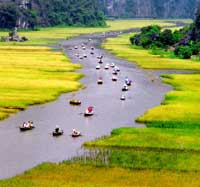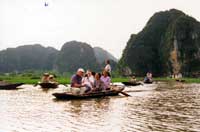|
Grottos more than a picture
(27-03-2009)
http://vietnamnews.vnagency.com.vn/showarticle.php?num=01TRA270309
by Thuy Hang
 |
|
Perfect shot: The
stunning landscape of Tam Coc
attracts thousand of tourists
every year. — VNA/VNS Photo Dinh
Na |
 |
|
Serenity: Foreign
tourists enjoy the relaxing and
peaceful landscape of the Tam
Coc. — VNA/VNS Photo Nguyen Dan |
NINH
BINH — There’s a reason why Tam Coc tourist
site in the northern province of Ninh Binh
rivals Ha Long Bay on the tourist must-see
list.
Tam
Coc, also known as Ha Long Bay on land, is
home to an awesome stretch of giant
limestone karsts jutting out of the rice
paddies surrounding a small river.
Located about 8km southwest of Ninh Binh
City, or 100km south from Ha Noi, Tam Coc,
which literally means "Three Grottos", is a
secluded oasis away from the big city.
The
journey to Tam Coc starts from the Van Lam
wharf – where visitors can step inside a
typical scene from a northern village.
There’s an ancient banyan tree, a river
wharf surrounded by bamboo boats and a
communal house.
"The
landscape is seemingly untouched by time and
that’s the way locals want it to stay," says
Vu Thi Tuyet Nhung, a tour guide for Tam
Coc-Bich Dong Tourism Site’s Management
Board. "Although tourism has developed over
the past few years, they still want to keep
the original features of the region."
Tourist Tran Mui from HCM City, agrees. "Nobody
uses motor boats here because they would
disturb the natural landscape," he says,
gesturing to the bamboo boats tethered by
the jetty.
"Although the boats look flimsy, they are a
defining feature of this place."
Bobbing up and down on one of the bamboo
vessels, surrounded by the beautiful
landscape and breathing in the fresh air –
it’s idyllic, says Linh Nham, a visitor from
Hoang Mai District in Ha Noi.
"Coming here makes me feel light-hearted and
calm."
Rocking boat
Once
you push off from the jetty, your little
boat will take you down the river, which
winds like a silk ribbon around the
limestone mountains.
Colours change with every season. The bright
green paddies that stretch out alongside the
water turn golden when the harvest season
comes in June. And come the wet season from
August to September, the river is covered
with purple water lillies.
It’s
difficult to take a bad photograph here.
Krist
Van Laere, a Belgian tourist, says he came
to Tam Coc after seeing a photo of the area
in his travel guide.
"I was
really impressed by the photo. It was taken
from above and showed the winding river,
speckled with tiny boats, meandering through
the rice fields. When I came here, I
realised the picture was completely faithful
to reality. It’s so relaxing and peaceful
here."
Grotto extraordinaire
Floating downstream, visitors eventually
come to Ca Grotto – the first of three
grottoes on the Tam Coc tour. This natural
piece of art, dripping with stalactites and
stalagmites, is known across the country as
Nam thien de nhi dong (the second
nicest grotto in Viet Nam). It is the
longest and widest in the area.
If
visitors come to the cave in the morning,
they can see the cliff at the grotto’s
entrance sparkling with the reflection of
the dawn.
Once
you enter the cave, it is dark and all other
sounds seem muted apart from the gentle
swish of oars as they sweep through the
water.
Navigating the bamboo boats through the cave
takes skill, says Hanoian tourist Nham.
"The
rowers must be really good because they
never bump into one another and seem to know
exactly where they are going in the darkness,"
she says.
Having
emerged into the sunlight again, the next
cave over the river is 60m-long Hai Cave,
which opens like an enormous mouth filled
with long, sharp teeth. Droplets of water
fall from the tips of the stalactites into
the river.
The
final grotto is only around 100m from there
– named simply Ba Cave. It’s the shortest
and the lowest cave on the journey. Visitors
can reach up and touch the roof with their
hands if they don’t mind being dripped on.
The
next leg of the tour is on dry land – a trip
to a small temple built by a local resident
to worship the King of the Forest – Ong Ho
(Mr Tiger).
According to tour guide Nhung, in the
future, the tour will not end at this spot,
but will go on to nearby Trang An
Eco-Tourism complex and Hoa Lu, the capital
of the country between AD 968 and 1009.
"The
new trip should start in 2010," she says.
By
prolonging the tour to equally tranquil
spots that are more than easy on the eye,
you can’t really go wrong. — VNS |